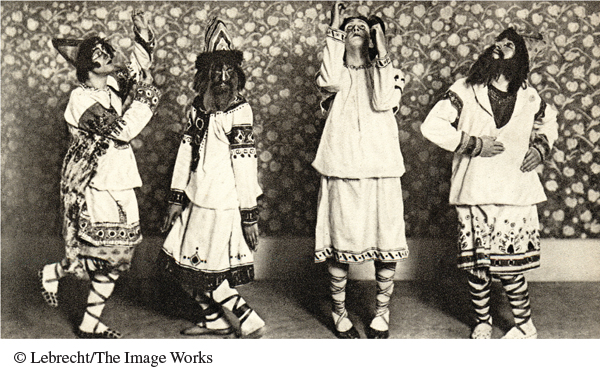Modern Music
Developments in modern music paralleled those in painting and fiction. Composers and performers expressed the emotional intensity and shock of modernism in radically experimental forms. The ballet The Rite of Spring by Russian composer Igor Stravinsky (1882–1971), for example, practically caused a riot when it was first performed in Paris in 1913. The combination of pulsating rhythms and dissonant sounds from the orchestra pit with earthy representations of lovemaking by the strangely dressed dancers on the stage shocked audiences accustomed to traditional ballet.
After the First World War, when irrationality and violence had seemed to pervade human experience, modernism flourished in opera and ballet. One of the most powerful examples was the opera Wozzeck, by Alban Berg (1885–1935), first performed in Berlin in 1925. Blending a half-sung, half-spoken kind of dialogue with harsh, atonal music, Wozzeck is a gruesome tale of a soldier driven by Kafka-like inner terrors and vague suspicions of infidelity to murder his mistress.

Modern Dance Dancers in Russian composer Igor Stravinsky’s avant-garde ballet The Rite of Spring perform at the Paris premiere. The dissonant music, wild sets and costumes, and unpredictable dance movements shocked and insulted the audience, which rioted on the opening night in May 1913.
(© Lebrecht/The Image Works)
Some composers turned their backs on long-established musical conventions. Just as abstract painters arranged lines and color but did not draw identifiable objects, so modern composers arranged sounds without creating recognizable harmonies. Led by Viennese composer Arnold Schönberg (SHURN-buhrg) (1874–1951), they abandoned traditional harmony and tonality. The musical notes in a given piece were no longer united and organized by a key; instead they were independent and unrelated. Schönberg’s twelve-tone music of the 1920s arranged all twelve notes of the scale in an abstract mathematical pattern, or “tone row.” This pattern sounded like no pattern at all to the ordinary listener and could be detected only by a highly trained eye studying the musical score. Accustomed to the harmonies of classical and romantic music, audiences generally resisted atonal music. Only after the Second World War did it begin to win acceptance.
